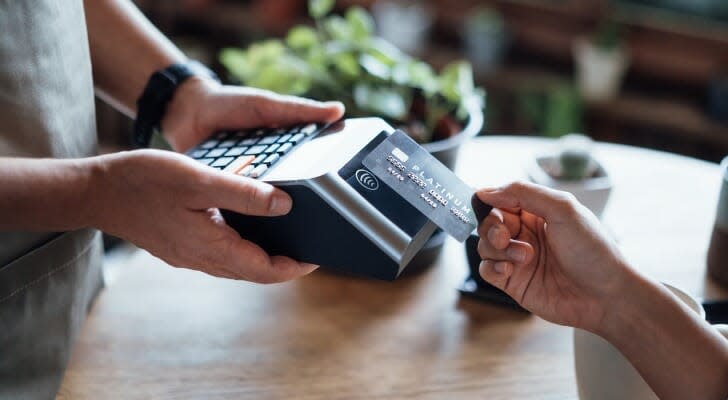Just about every bank puts a limit on how much cash you can withdraw each day. In part, this is a security feature to prevent thieves from cleaning out unauthorized accounts. In other part, this helps banks and ATMs to stabilize liquidity.If accessing cash, especially on an unscheduled basis, is important to you, here’s what you need to know about daily withdrawal limits from a personal account at a commercial bank.
If you’re not sure what type of financial institution should keep your money then you may want to consider working with a financial advisor.
What Are Withdrawal Limits?
A daily withdrawal limit is the maximum amount of money you can withdraw from your bank account in a single day. These limits largely exist for two reasons.
The first is to manage cash flow and liquidity. Banks keep a limited amount of cash on hand at any given time, as do ATMs. By setting withdrawal limits, the bank can control how much they have to distribute at any given time.
Just as importantly, if not more so, withdrawal limits are a security feature. By limiting daily withdrawals, banks help protect their customers against unauthorized access. Even if someone gets your debit card and PIN number, there’s a limit to the damage they can do.
There are three main categories of withdrawal limits:
ATM Withdrawals
This is by far the most common use of the term “withdrawal limit.” Your bank’s ATM withdrawal limit is the maximum amount of physical cash you can take out of an ATM in one 24-hour period. For example, many banks have a $500 limit, which means you can’t take out more than $500 in cash during a single 24-hour period.
Typically banks apply the ATM limit cumulatively, across all ATM transactions in a single 24-hour period. This means that it is not a limit on how much you can withdraw at once, but rather a limit on how much you can withdraw from ATMs altogether over the course of a day.
While your bank sets a limit on ATM withdrawals, individual ATM operators can do so as well. This limits how much money you can take out of that operator’s machines over the course of a single day. For example, say your bank has a $1,000 withdrawal limit and you use an ATM with a $600 limit. This means that you can withdraw up to $600 from that ATM operator’s machines in a single day, but you can withdraw an additional $400 from other ATMs before hitting your bank’s limit.
If you’re ready to be matched with local advisors that can help you achieve your financial goals, get started now.
Cashier/Teller Withdrawals
This is the maximum amount of physical cash that you can take out of your bank account in a 24-hour period by going into a branch and making a withdrawal in person. For example, your bank may limit cashier transactions to no more than $20,000 in physical cash each day.
This differs from an ATM withdrawal because you’re working directly with a teller, which obviates some of the security concerns. The branch will also have significantly more cash on hand than an ATM, which reduces liquidity concerns.
While banks will often have some sort of cash withdrawal limit, they will typically be much higher than ATM withdrawal limits. In some cases this will be a general limit on cash transactions, meaning that the same limit would also apply to transactions like redeeming a check for cash. Banks may also set their limits around immediate transactions, meaning that you can withdraw large amounts of cash but need to make your request in advance.
Debit Withdrawal Limit
This is the maximum amount that you can spend with your debit card in a 24-hour period. For example, your bank may have a maximum of $5,000 in debit card spending each day.
Banks treat debit card transactions as the electronic equivalent of a cash transfer. Since this is an electronic payment, a debit card doesn’t present any special liquidity issues. However, it does present the same security concerns as an ATM withdrawal. As a result, it’s not uncommon for banks to impose debit withdrawal limits. When they exist, however, these limits are virtually always higher than ATM withdrawal limits.
Legal and Savings Withdrawal Limits
For a standard depository account, there are no laws or legal limits to how much cash you can withdraw. Withdrawal limits are set by the banks themselves and differ across institutions.That said, cash withdrawals are subject to the same reporting limits as all transactions. If you withdraw $10,000 or more, federal law requires the bank to report it to the IRS in an effort to prevent money laundering and tax evasion.
Few, if any, banks set withdrawal limits on a savings account. The main restriction on a savings account is the transaction limit, which is a legal limit of no more than six transactions through a savings account each month. You also have less access to a savings account, since these typically don’t come with products like checkbooks or debit cards. However, within those limitations, you can generally move any amount of money that you please.
Checking Withdrawal Limits
Every bank has its own rules when it comes to daily withdrawal limits, and these terms can vary widely. Most, if not all, banks set the lowest limits on ATM withdrawals. They have higher limits for debit transactionsand still higher limits for cashier transactions.Banks may also set different transaction limits based on your account. For example, a newer account, no-fee checking or student checking accounts may have low withdrawal limits. By contrast, a longstanding customer or one with a high-interest checking account may have a much higher withdrawal limit than usual.
While a comprehensive list of withdrawal fees is beyond the scope of this article, here is a representative sample of ATM and debit withdrawal limits at eight banks at the time of writing. Note that these are representative numbers only. Your specific limits at any given bank will depend on your account type and usage.
Bank Daily ATM Limit Daily Debit Limit Bank of America $1,000 or 60 individual bills $5,000 Capital One $5,000 for most accounts $5,000 for most accounts Chase $500-$3,000 $3,000 Citi $1,500-$2,000 $5,000-$10,000 PNC $500-$2,000 $2,000-$5,000 TD Bank Starts at $1,000 No specified limit U.S. Bank Starts at $500 Starts at $10,000 Wells Fargo Starts at $300 $600-$10,000
When you open a bank account, it’s important to learn what withdrawal limits come with it. In particular, make sure you ask about any debit limits. Your bank may not have debit limits, or at least not for all accounts, but they can be very important. For example, say your bank sets a $3,000 limit on debit spending in a 24-hour period. While you may not ordinarily need to think about that limit, on a day in which you pay for airfare or make some other large purchase you could be at risk of having your card declined.
The Bottom Line
An ATM withdrawal limit is the maximum amount of cash that your bank will let you take out of ATMs in a single day. Your debit spending limit, if any, is the most you can spend with your debit card in a single day.
Every bank has different rules around this, so make sure you understand your own account’s limits.
Tips on Banking
For any given bank account, your account limits will partially depend on the specific type of account you have. So the first step is making sure you have the right account for you.
A financial advisor can provide valuable insight and guidance as you make choices about types of banks to use. If you don’t have a financial advisor yet, finding one doesn’t have to be hard. SmartAsset’s free tool matches you with up to three vetted financial advisors who serve your area, and you can interview your advisor matches at no cost to decide which one is right for you. If you’re ready to find an advisor who can help you achieve your financial goals, get started now.
Photo credit: ©iStock.com/dobok, ©iStock.com/AsiaVision, ©iStock.com/mladenbalinovac
The post How Much Cash Can You Withdraw From Your Bank? appeared first on SmartAsset Blog.
As an expert in banking and financial matters, I'll provide a comprehensive breakdown of the concepts mentioned in the article.
-
Daily Withdrawal Limits:
- Definition: A daily withdrawal limit refers to the maximum amount of money an account holder can withdraw from their bank account in a single day.
- Purpose:
- Cash Flow and Liquidity Management: Banks and ATMs maintain a limited amount of cash at any given time. Setting withdrawal limits helps manage cash flow and liquidity by controlling the amount available for distribution.
- Security Feature: Limits act as a security measure to prevent unauthorized access and mitigate potential losses. Even if a debit card and PIN are compromised, there's a cap on the potential damage.
-
Categories of Withdrawal Limits:
- ATM Withdrawals:
- Definition: The maximum amount of physical cash that can be withdrawn from an ATM in a 24-hour period.
- Cumulative Limit: Typically applied cumulatively across all ATM transactions within a day.
- Cashier/Teller Withdrawals:
- Definition: The maximum amount of physical cash that can be withdrawn in person at a bank branch within a 24-hour period.
- Higher Limits: Generally higher than ATM withdrawal limits due to the increased security of working directly with a teller.
- Debit Withdrawal Limit:
- Definition: The maximum amount that can be spent with a debit card in a 24-hour period.
- Electronic Equivalent: Debit card transactions are treated as the electronic equivalent of a cash transfer.
- ATM Withdrawals:
-
Legal and Savings Withdrawal Limits:
- Depository Account: No legal limits on cash withdrawal, but banks set their own limits.
- Reporting Limits: Cash withdrawals of $10,000 or more trigger reporting to the IRS to prevent money laundering and tax evasion.
- Savings Account: Subject to transaction limits (usually six per month) rather than withdrawal limits.
-
Checking Withdrawal Limits:
- Varied Limits: Each bank sets its own rules with varying limits.
- Account-Specific Limits: Limits may differ based on account type, with newer or specific accounts having lower withdrawal limits.
-
Sample Withdrawal Limits at Eight Banks:
- Bank Differences: Daily ATM and debit limits vary among different banks.
- Account Type Dependency: Limits depend on the account type and individual usage.
-
Considerations and Tips:
- Debit Limits Importance: Understanding debit limits is crucial, as exceeding them can lead to declined transactions.
- Account-Specific Limits: Account holders should inquire about and be aware of their specific account limits.
-
Financial Advisor Recommendation:
- Account Selection Guidance: A financial advisor can provide valuable guidance in choosing the right type of bank account based on individual needs.
- SmartAsset's Tool: SmartAsset's tool matches individuals with vetted financial advisors, facilitating informed decision-making.
In conclusion, the article emphasizes the importance of understanding and being aware of the withdrawal limits associated with different types of bank transactions, and it highlights the role of financial advisors in providing tailored guidance for optimal account selection.



